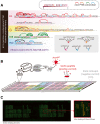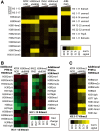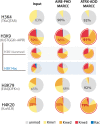ChIP-less analysis of chromatin states
- PMID: 24872844
- PMCID: PMC4022240
- DOI: 10.1186/1756-8935-7-7
ChIP-less analysis of chromatin states
Abstract
Background: Histone post-translational modifications (PTMs) are key epigenetic regulators in chromatin-based processes. Increasing evidence suggests that vast combinations of PTMs exist within chromatin histones. These complex patterns, rather than individual PTMs, are thought to define functional chromatin states. However, the ability to interrogate combinatorial histone PTM patterns at the nucleosome level has been limited by the lack of direct molecular tools.
Results: Here we demonstrate an efficient, quantitative, antibody-free, chromatin immunoprecipitation-less (ChIP-less) method for interrogating diverse epigenetic states. At the heart of the workflow are recombinant chromatin reader domains, which target distinct chromatin states with combinatorial PTM patterns. Utilizing a newly designed combinatorial histone peptide microarray, we showed that three reader domains (ATRX-ADD, ING2-PHD and AIRE-PHD) displayed greater specificity towards combinatorial PTM patterns than corresponding commercial histone antibodies. Such specific recognitions were employed to develop a chromatin reader-based affinity enrichment platform (matrix-assisted reader chromatin capture, or MARCC). We successfully applied the reader-based platform to capture unique chromatin states, which were quantitatively profiled by mass spectrometry to reveal interconnections between nucleosomal histone PTMs. Specifically, a highly enriched signature that harbored H3K4me0, H3K9me2/3, H3K79me0 and H4K20me2/3 within the same nucleosome was identified from chromatin enriched by ATRX-ADD. This newly reported PTM combination was enriched in heterochromatin, as revealed by the associated DNA.
Conclusions: Our results suggest the broad utility of recombinant reader domains as an enrichment tool specific to combinatorial PTM patterns, which are difficult to probe directly by antibody-based approaches. The reader affinity platform is compatible with several downstream analyses to investigate the physical coexistence of nucleosomal PTM states associated with specific genomic loci. Collectively, the reader-based workflow will greatly facilitate our understanding of how distinct chromatin states and reader domains function in gene regulatory mechanisms.
Keywords: Affinity enrichment; Antibody-free; Chromatin; Histone; PTM; Peptide microarray; Reader domain.
Figures





Similar articles
-
MARCC (Matrix-Assisted Reader Chromatin Capture): An Antibody-Free Method to Enrich and Analyze Combinatorial Nucleosome Modifications.Curr Protoc Mol Biol. 2015 Jul 1;111:21.32.1-21.32.21. doi: 10.1002/0471142727.mb2132s111. Curr Protoc Mol Biol. 2015. PMID: 26131849 Free PMC article.
-
Nucleosome conformation dictates the histone code.Elife. 2024 Feb 6;13:e78866. doi: 10.7554/eLife.78866. Elife. 2024. PMID: 38319148 Free PMC article.
-
Reading the Combinatorial Histone Language.ACS Chem Biol. 2016 Mar 18;11(3):564-74. doi: 10.1021/acschembio.5b00864. Epub 2015 Dec 21. ACS Chem Biol. 2016. PMID: 26675328 Free PMC article. Review.
-
The dCypher Approach to Interrogate Chromatin Reader Activity Against Posttranslational Modification-Defined Histone Peptides and Nucleosomes.Methods Mol Biol. 2022;2458:231-255. doi: 10.1007/978-1-0716-2140-0_13. Methods Mol Biol. 2022. PMID: 35103971
-
Application of modified histone peptide arrays in chromatin research.Arch Biochem Biophys. 2019 Jan;661:31-38. doi: 10.1016/j.abb.2018.10.019. Epub 2018 Nov 2. Arch Biochem Biophys. 2019. PMID: 30391375 Review.
Cited by
-
MARCC (Matrix-Assisted Reader Chromatin Capture): An Antibody-Free Method to Enrich and Analyze Combinatorial Nucleosome Modifications.Curr Protoc Mol Biol. 2015 Jul 1;111:21.32.1-21.32.21. doi: 10.1002/0471142727.mb2132s111. Curr Protoc Mol Biol. 2015. PMID: 26131849 Free PMC article.
-
Histone peptide microarray screen of chromo and Tudor domains defines new histone lysine methylation interactions.Epigenetics Chromatin. 2017 Mar 14;10:12. doi: 10.1186/s13072-017-0117-5. eCollection 2017. Epigenetics Chromatin. 2017. PMID: 28293301 Free PMC article.
-
ATRX Plays a Key Role in Maintaining Silencing at Interstitial Heterochromatic Loci and Imprinted Genes.Cell Rep. 2015 Apr 21;11(3):405-18. doi: 10.1016/j.celrep.2015.03.036. Epub 2015 Apr 9. Cell Rep. 2015. PMID: 25865896 Free PMC article.
-
Hydroxamic acid-modified peptide microarrays for profiling isozyme-selective interactions and inhibition of histone deacetylases.Nat Commun. 2021 Jan 4;12(1):62. doi: 10.1038/s41467-020-20250-9. Nat Commun. 2021. PMID: 33397936 Free PMC article.
-
Histones: at the crossroads of peptide and protein chemistry.Chem Rev. 2015 Mar 25;115(6):2296-349. doi: 10.1021/cr5003529. Epub 2014 Oct 20. Chem Rev. 2015. PMID: 25330018 Free PMC article. Review. No abstract available.
References
-
- Phanstiel D, Brumbaugh J, Berggren WT, Conard K, Feng X, Levenstein ME, McAlister GC, Thomson JA, Coon JJ. Mass spectrometry identifies and quantifies 74 unique histone H4 isoforms in differentiating human embryonic stem cells. Proc Natl Acad Sci U S A. 2008;105(11):4093–4098. doi: 10.1073/pnas.0710515105. - DOI - PMC - PubMed
Grants and funding
LinkOut - more resources
Full Text Sources
Other Literature Sources
Miscellaneous

